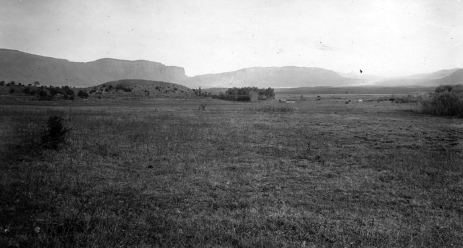In a small community near a broad expanse of valley floor known as the West End, there’s a certain glow in the air. It’s the glow of progress, the glow of prosperity … and the glow of the uranium miners coming home from work?
 The Paradox Valley in southwestern Colorado.Courtesy U.S. Geological SurveyProbably not; we all know radiation doesn’t actually make someone glow. However, the people of Paradox Valley in western Colorado may soon have a unique opportunity to rediscover exactly what impact uranium mining and refining can have.
The Paradox Valley in southwestern Colorado.Courtesy U.S. Geological SurveyProbably not; we all know radiation doesn’t actually make someone glow. However, the people of Paradox Valley in western Colorado may soon have a unique opportunity to rediscover exactly what impact uranium mining and refining can have.
Energy Fuel Resources Corp (EFR), a wholly-owned subsidiary of Toronto-based Energy Fuels, has a proposal on the table that, if passed, will allow the first uranium/vanadium refinery to be built on U.S. soil in 25 years. Residents of the area are up in arms and have begun a petition which they hope will stop the proposal dead. Time is short; the final public meeting is scheduled for June 10, 2009, which gives them just one day to get enough signatures. You can sign the petition here.
So what exactly do uranium/vanadium mills produce? Similar to oil refineries, they take raw uranium/vanadium ore and turn it into enriched uranium that can be used in nuclear plants, the medical field, nuclear weapons, and a wide variety of other applications.
Unfortunately, uranium mills and mining also produce millions of tons of radioactive waste, called “tailings,” that are stored in giant pits lined with multiple layers of plastic (called “cells”) and then buried with more dirt or clay (called the “cap”). Radioactive dust from the tailings — radon — is released through the cap to disperse in the air. The sites are continuously monitored to ensure that the radon diffuses sufficiently so that it doesn’t harm the nearest full-time inhabitants. These radioactive remains pose a threat to people, animals, and agriculture through air and water-borne contaminants. (More information on uranium mining impacts in the area is online here.)
Because the site is on private land (privately owned by the company building the mill), the only other agency besides the county that will regulate the mill operations will be the Colorado Department of Health and the Environment. No federal oversight or environmental impact statement will be required (Telluride Daily Planet, May 30, 2009).
Even more interesting than the proposed uranium mill are all of the old and new uranium mining sites to which EFR has purchased the rights. In the near term, the company plans to reopen two mine sites in Colorado (both a few miles from a brand-new resort and spa in Gateway) and one nearby in Utah. In addition, ERF has obtained the rights to explore 16 other sites in Colorado and Utah, and controls more than 200 other sites on 1,120 acres in northern Arizona. All of these locations are technically close enough to the proposed mill site for truck delivery of raw uranium/vanadium ore.
Of course, not everyone is against the proposal. It will create 85 full-time jobs in a relatively low-income area with fewer than 2,000 residents. Not only that, developing new mines and reopening old ones in Colorado, Arizona, and New Mexico could potentially create a uranium-mining boom the likes of which haven’t been seen since the bountiful days of Cold War bomb making. EFR estimates that at least 200 more full-time positions could open in Colorado alone as these mines expand production.
The inhabitants of the area are familiar with the impact of uranium mining. This area was one of the uranium meccas of the Southwest for decades; in fact the federal government just finished a Superfund uranium clean-up project at the now-abandoned town of Uravan, a nearby uranium boom-town started in the 1920s. The Superfund project took 22 years to complete, starting in 1986 and closing in September of 2008. The total cost of the clean-up effort was $127 million, with an additional $750,000 assigned to fund long-term surveillance of the site. (More information on the Superfund project is online here.)
Historically, uranium miners in towns such as Nucla and Naturita died from lung cancer at five times the number expected in a similar-sized group of American men, according to the National Institute of Occupational Safety and Health and the New Mexico Tumor Registry (Durango Telegraph, Jan. 17, 2008). In Montrose County, where Uravan lies, cancer rates happen to be some of the highest in the state (National Cancer Institute, 2001-2005 averages). However, as former Nucla mayor Roxy Allex said, “People need to make a living, and the bottom line is you can’t be picky about what you do when your family’s food on the table is the big issue.”



